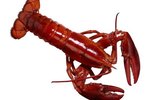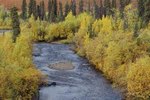
Their name is a combination of two Greek words loosely meaning oar-footed or paddle-footed. They’re tiny crustaceans that average 8/100 of an inch, or 2 millimeters, in length -- about the thickness of a dime. Copepods may not be commonly recognized, but they’re an important part of evolution. They’re a keystone factor in our ecology, and scientists have studied them for centuries.
Six Degrees of Separation
Copepods fascinate scientists for various reasons. The World Association of Copepodologists has more than 50,000 published works dating back almost 2,000 years, including observations by Aristotle. In the mid-1880s, scientists began documenting the direct and indirect links between species. They began indicating how copepods play a large role in this fascinating chain. Among their many benefits, copepods are food for fish, birds and a variety other animals. These animals are food for others that eventually link to the feeding and survival of humans.
Water, Water Everywhere
Scientists have found copepods living in waters around the globe. They’re in fresh water and oceans from the surfaces to the depths. They’re in frigid polar waters as well as hot springs, rivers, lakes, streams and caves. They also live in the stagnant waters of leaf litters and old tires. Conservatively, there are more than 10,000 species of recognized copepods, making them the most abundant multi-celled animal on the planet, even more than insects.
Food for Thought
Copepods keep our oceans and waters clean by eating algae, bacteria and dead matter. They also feed on mosquito larva, which helps control malaria and other mosquito-borne diseases. They’re part of an important ecological group known as filter feeders who feed on floating particles. Among others, this group includes jellyfish and mollusks -- one blue mussel can filter almost 3 gallons of water in an hour. An over-harvesting of oysters in Maryland’s Chesapeake Bay once led to a devastating ecological impact. Without the oyster’s filtration, there was an overgrowth of plankton that deprived the water of oxygen, killing other aquatic bay animals.
The Eternal Spring
Their reproduction abilities also play an interesting role in copepods' survival. Male and females can mate, or a female can produce cysts on her own. Some cysts may hatch right away, while others rest on the bottom. If the water source is a spring pool that dries up, the cysts will remain buried until the rains return. Scientists have found copepod cysts estimated to be 300 years old. These cysts hatched when put back into water.
References
Photo Credits
-
David De Lossy/Digital Vision/Getty Images
Writer Bio
Slone Wayking worked as a professional in the veterinary field for 20 years. Though her interest in animal health led to this path, Wayking initially studied creative arts. She has been article writing for more than a year and is currently working towards her degree in multimedia. Her certifications include business writing and basic web design.




